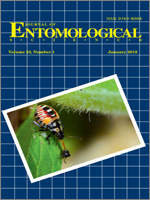There is limited knowledge regarding the biology of beetles in Cossoninae and Scolytinae (Curculionidae) in South Africa. It has recently been found that beetles in these two weevil subfamilies are associated with Euphorbia ingens E. Meyer: Boissier die-offs in the country. Lindgren traps baited with 95% ethanol were set at three sites in two provinces of South Africa to gain an understanding of the seasonal activity of the beetles that infest E. ingens. Temperature and relative humidity were monitored at each site to correlate environmental conditions with beetle flight patterns. Seven beetle species, of which six were in Scolytinae and one in Cossoninae, were captured in the traps over a period of 20 mo. Eccoptopterus spinosus Olivier, Premnobius cavipennis Eichhoff and Xyleborinus spinifer Eggers were the most commonly caught beetles. Ambrosiodmus natalensis Schedl, E. spinosus, P. cavipennis, and X. spinifer are reported from South Africa for the first time. Of the seven beetle species, two, Cyrtogenius africus Wood and a Stenoscelis sp. Wollaston, are known to colonize diseased and dying E. ingens trees, but these were trapped in low numbers, possibly due to the choice of bait used. The number of C. africus and Stenoscelis sp. caught varied with temperature and humidity, but only temperature had a significant effect on numbers captured. The number of C. africus and Stenoscelis sp. caught appeared to be a function of site and climatic conditions as opposed to E. ingens mortality levels.
How to translate text using browser tools
1 January 2018
Seasonal Flight Patterns of Curculionidae (Cossoninae and Scolytinae) Infesting Dying Euphorbia ingens in South Africa1
Johannes A. Van der Linde,
Mike J. Wingfield,
Diana L. Six,
Jolanda Roux
ACCESS THE FULL ARTICLE
ambrosia beetles
Cyrtogenius africus
Lindgren funnel trap
weevils





